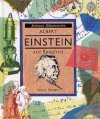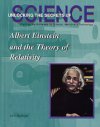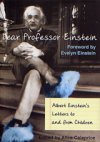Einstein’s Skateboard Additional Information
Information about the Discovery Channel Young Scientist Challenge (DCYSC) is available at www.sciserv.org/dysc/ (Science Service) and school.discovery.com/sciencefaircentral/dysc/ (Discovery Channel). You can learn more about this year’s winners at school.discovery.com/sciencefaircentral/dysc/finalists/winners.html (Discovery Channel) and www.sciencenewsforkids.org/pages/sciencefairzone/news.asp.
Learn more about the “World Year of Physics 2005: Einstein in the 21st Century” at www.physics2005.org/(World Year of Physics).
You can find out more about the science of skateboarding at www.exploratorium.edu/skateboarding/(Exploratorium).
Sohn, Emily. 2003. Young scientists take flight. Science News for Kids (Oct. 29). Available at http://www.sciencenewsforkids.org/articles/20031029/Feature1.asp.
Books recommended by SearchIt!Science:
 |
Albert Einstein and Relativity— Steve Parker
Published by Chelsea House, 1994.
Albert Einstein is one of the most famous scientists ever, and yet many people do not understand his theories. While growing up in southern Germany, Einstein studied the work of great physicists. He published his “special theory of relativity,” which built upon the work of earlier scientists. Einstein did not stop there—he also developed a “principle of equivalence” to explain the relationship between the force of gravity and the force created when things speed up. Throughout his life, Einstein was active in science and politics. |
 |
Albert Einstein and the Theory of Relativity— John Bankston
Published by Mitchell Lane Publishers, 2003.
You’ve probably heard of Albert Einstein—after all, he is probably the most famous scientist on Earth. But do you know how this man, who was a “lowly patent clerk” when he wrote his theories, became such a famous scientist—or what exactly he became so famous for? This book tells the story of the physicist whose writings changed the way we think about light, matter, and energy. Learn about his childhood in Germany, his struggle to get an education in Switzerland, and his relationship with his wife Mileva. In this biography, tales of Einstein’s personal life are balanced with readable explanations of his theories of relativity, along with a chapter that mentions his work for peace later in life. |
 |
Dear Professor Einstein: Albert Einstein’s Letters to and from Children— Alice Calaprice
Published by Prometheus Books, 2002
If you were writing a letter to Einstein, what would you say? And what might Einstein write back? This book, written by an Einstein scholar, is a collection of Einstein’s letters from children. “Dear Albert,” one of them begins, “I have just read a book which tries to explain your Theory of Relativity. I am sorry but I cannot understand it. But then I blame only myself as I am still a young school boy and have not advance to your level of thought.” Another letter asks Einstein, “Do scientists pray, and what do they pray for?” The letters, from children all around the world, are accompanied by Einstein’s reply, when possible. With a forward by Evelyn Einstein, Albert’s granddaughter, the book includes a biography of Einstein, an essay on his philosophy of education, and a black-and-white picture gallery. |
Power Words
acceleration A continuing change in the speed or direction of a moving object. Acceleration does not just mean going faster and faster; it can mean slowing down as well. An object that moves in a curving path instead of a straight line, even when its speed is constant, is also undergoing acceleration because it is always changing direction.
Einstein, Albert. Born 1879; died 1955. German-born American scientist whose theories changed the way scientists understand space and time. Einstein formulated the theory of relativity. He explained that light was made not just of waves but of particles. He also developed a new way of understanding gravity.
relativity A two-part theory of physics developed by Albert Einstein. The first part states that the laws of physics are the same for all objects, even if they are moving, and that the speed of light is the same everywhere. The second part states that gravity is not a force but a bending of space.
Copyright © 2002, 2003 Houghton-Mifflin Company. All rights reserved. Used with permission.
